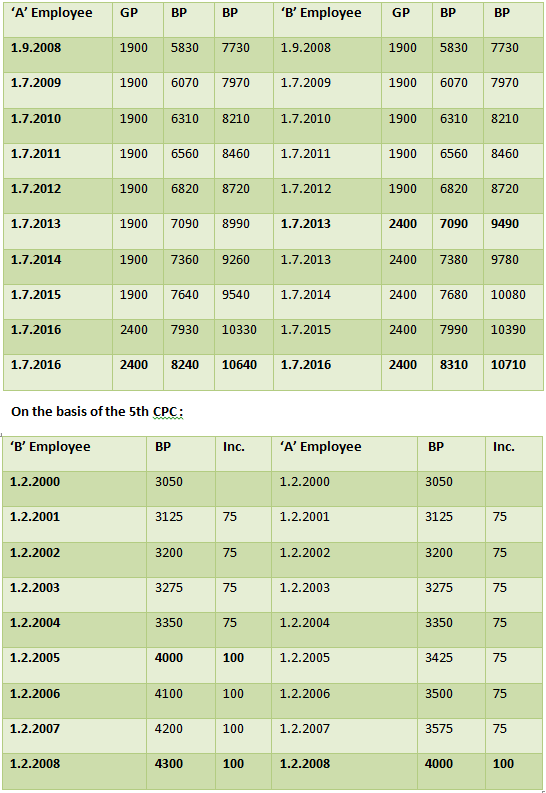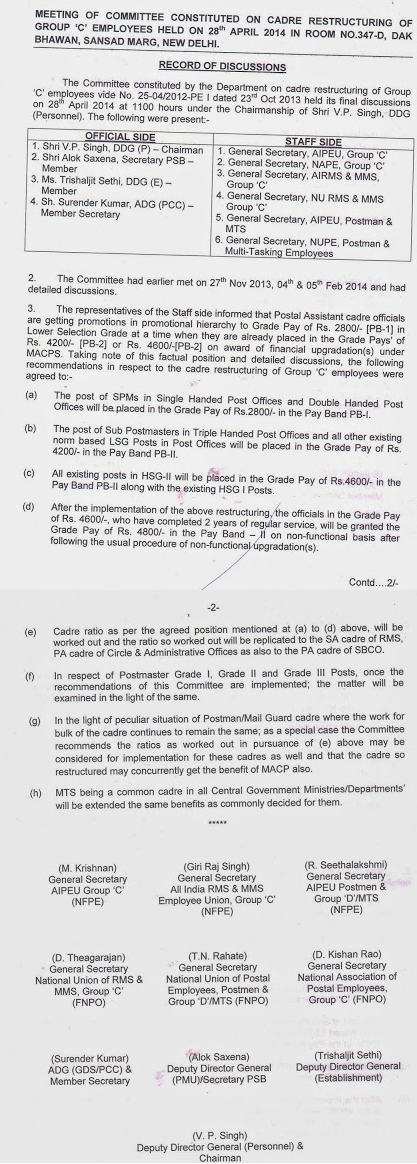7CPC: IPS officers, IRS officers seek pay parity with IAS officers from 7th pay panel
New Delhi: Various service associations of All India Services and allied services have represented to the Seventh Pay Commission seeking pay parity with IAS officers and adequate representation in central government’s policy making positions.
Officers associations of Indian Police Service (IPS), Indian Revenue Service (IRS), Indian Audit and Accounts Service (IA&AS) and Indian Forest Service (IFoS) have made detailed presentations to the Pay Commission about their grievances and suggestions for the future.
Though made separately, the associations’ presentations unanimously voiced their demand for ensuring pay parity with IAS officers and a share in Joint Secretary-level posts at the Centre.
Though made separately, the associations’ presentations unanimously voiced their demand for ensuring pay parity with IAS officers and a share in Joint Secretary-level posts at the Centre.
The Indian Revenue Service officials demanded that top level posts be increased to accommodate them on par with IAS officers. Asserting that they were involved in the important task of collecting revenue for the government, the IRS officers association said the superiority of IAS and Indian Foreign Services (IFS) officers should go as they did not face any hardships.
Listing out the “disparities”, the associations complained about delay in empanelment of officers of their services as Joint Secretaries at the centre vis-a-vis IAS officers. For example, they said, while a 1997 batch IAS officer is empanelled as Joint Secretary, for empanelment of an IPS officer he has to be of the 1993 batch, 1994 batch for IA&AS and 1989 for IFoS.
These organisations deprecated IAS officers deciding the fate of other All India Services and Allied services officers.
The IRS officers also demanded positions ranging from Superintendents of Police to Joint Directors in the CBI for its officers, claiming they were equipped to deal with economic crimes.
IA&AS memorandum also sought equality in rules governing central deputation and allowances.
In its representation, the IPS Officers Association deplored that its demand for pay parity with IAS and IFS has been ignored by successive Pay Commissions.
“But the same (their demand) has not found favour with the Commission. Unfortunately, the reasons for turning down the request were never based on merit but through direct acceptance of flawed arguments made by the other side on the basis of specious premises,” it said.
The IPS officers also demanded that there be more options for them in central staffing and policy making, especially police-specific jobs like internal security division under the Union Home Ministry.
There are hardly any joint secretary or secretary level officers in the bureaucracy from IPS. The memorandum also said that out of 111 posts of Central Vigilance Officers, only 21 were occupied by IPS officers.
It also spoke about the duty of a police officer which went beyond his ordinary scheduled work hours. “A police officer is subject to restrictions on his private life, one of which is the obligation to obey an order to return to duty,” it said.
The duty hours spanned more than 16 hours a day and, therefore, there was a need to introduce an ‘Overtime Allowance’ for police personnel.
Previous UPA regime had announced the Seventh Pay Commission which was constituted on February 28, 2014. Chaired by Justice Ashok Kumar Mathur, it has Vivek Rae as full-time Member, Ratin-Roy as part time Member and Meena Agarwal as Secretary.
The Commission has been given 18 months to submit its recommendations and its term expires in October this year.
PTI
New Delhi: Various service associations of All India Services and allied services have represented to the Seventh Pay Commission seeking pay parity with IAS officers and adequate representation in central government’s policy making positions.
Officers associations of Indian Police Service (IPS), Indian Revenue Service (IRS), Indian Audit and Accounts Service (IA&AS) and Indian Forest Service (IFoS) have made detailed presentations to the Pay Commission about their grievances and suggestions for the future.
Though made separately, the associations’ presentations unanimously voiced their demand for ensuring pay parity with IAS officers and a share in Joint Secretary-level posts at the Centre.
Though made separately, the associations’ presentations unanimously voiced their demand for ensuring pay parity with IAS officers and a share in Joint Secretary-level posts at the Centre.
The Indian Revenue Service officials demanded that top level posts be increased to accommodate them on par with IAS officers. Asserting that they were involved in the important task of collecting revenue for the government, the IRS officers association said the superiority of IAS and Indian Foreign Services (IFS) officers should go as they did not face any hardships.
Listing out the “disparities”, the associations complained about delay in empanelment of officers of their services as Joint Secretaries at the centre vis-a-vis IAS officers. For example, they said, while a 1997 batch IAS officer is empanelled as Joint Secretary, for empanelment of an IPS officer he has to be of the 1993 batch, 1994 batch for IA&AS and 1989 for IFoS.
These organisations deprecated IAS officers deciding the fate of other All India Services and Allied services officers.
The IRS officers also demanded positions ranging from Superintendents of Police to Joint Directors in the CBI for its officers, claiming they were equipped to deal with economic crimes.
IA&AS memorandum also sought equality in rules governing central deputation and allowances.
In its representation, the IPS Officers Association deplored that its demand for pay parity with IAS and IFS has been ignored by successive Pay Commissions.
“But the same (their demand) has not found favour with the Commission. Unfortunately, the reasons for turning down the request were never based on merit but through direct acceptance of flawed arguments made by the other side on the basis of specious premises,” it said.
The IPS officers also demanded that there be more options for them in central staffing and policy making, especially police-specific jobs like internal security division under the Union Home Ministry.
There are hardly any joint secretary or secretary level officers in the bureaucracy from IPS. The memorandum also said that out of 111 posts of Central Vigilance Officers, only 21 were occupied by IPS officers.
It also spoke about the duty of a police officer which went beyond his ordinary scheduled work hours. “A police officer is subject to restrictions on his private life, one of which is the obligation to obey an order to return to duty,” it said.
The duty hours spanned more than 16 hours a day and, therefore, there was a need to introduce an ‘Overtime Allowance’ for police personnel.
Previous UPA regime had announced the Seventh Pay Commission which was constituted on February 28, 2014. Chaired by Justice Ashok Kumar Mathur, it has Vivek Rae as full-time Member, Ratin-Roy as part time Member and Meena Agarwal as Secretary.
The Commission has been given 18 months to submit its recommendations and its term expires in October this year.
PTI














